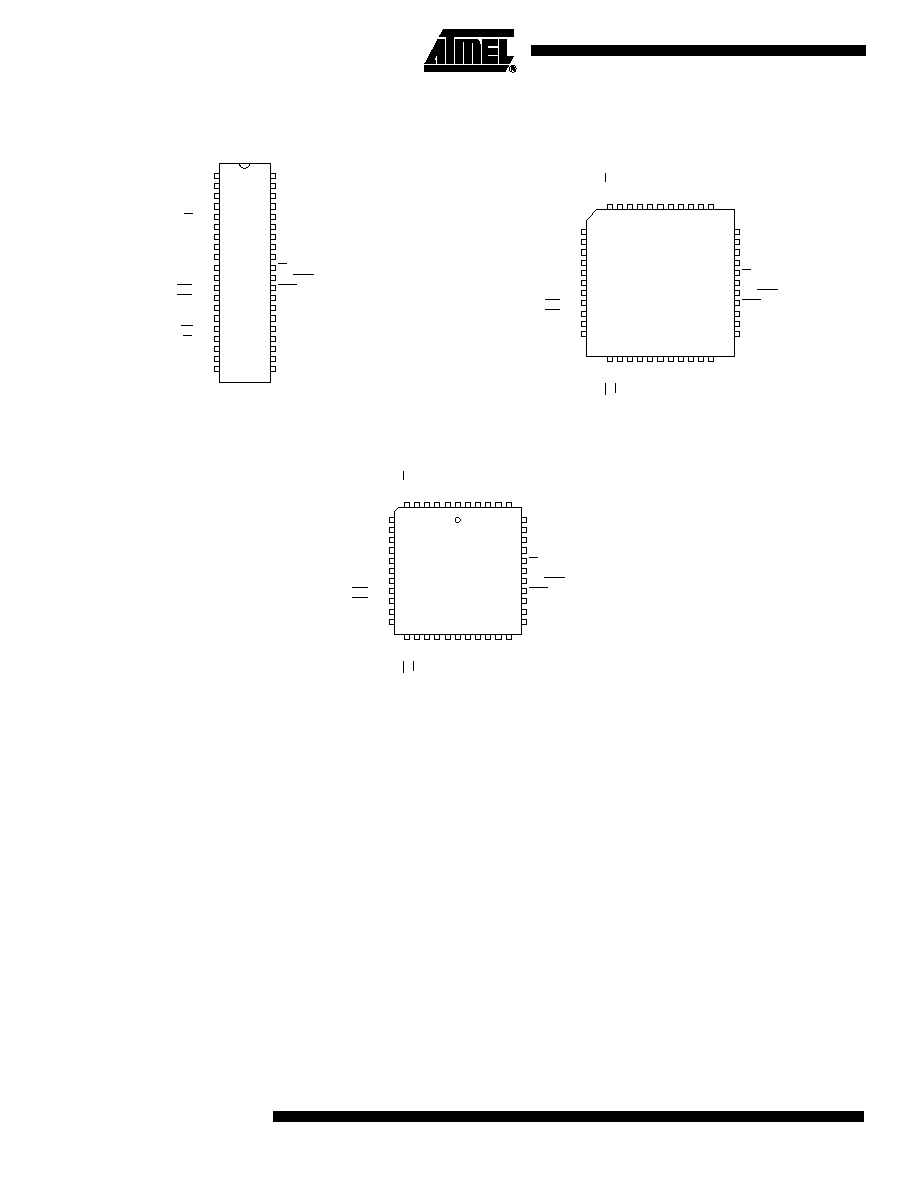
1
0401F≠MICRO≠11/03
Features
∑
Compatible with MCS
Æ
51
Products
∑
8K Bytes of In-System Reprogrammable Downloadable Flash Memory
≠ SPI Serial Interface for Program Downloading
≠ Endurance: 1,000 Write/Erase Cycles
∑
2K Bytes EEPROM
≠ Endurance: 100,000 Write/Erase Cycles
∑
4V to 6V Operating Range
∑
Fully Static Operation: 0 Hz to 24 MHz
∑
Three-level Program Memory Lock
∑
256 x 8-bit Internal RAM
∑
32 Programmable I/O Lines
∑
Three 16-bit Timer/Counters
∑
Nine Interrupt Sources
∑
Programmable UART Serial Channel
∑
SPI Serial Interface
∑
Low-power Idle and Power-down Modes
∑
Interrupt Recovery from Power-down
∑
Programmable Watchdog Timer
∑
Dual Data Pointer
∑
Power-off Flag
Description
The AT89S8252 is a low-power, high-performance CMOS 8-bit microcontroller with 8K
bytes of downloadable Flash programmable and erasable read-only memory and 2K
bytes of EEPROM. The device is manufactured using Atmel's high-density nonvolatile
memory technology and is compatible with the industry-standard 80C51 instruction
set and pinout. The on-chip downloadable Flash allows the program memory to be
reprogrammed In-System through an SPI serial interface or by a conventional nonvol-
atile memory programmer. By combining a versatile 8-bit CPU with downloadable
Flash on a monolithic chip, the Atmel AT89S8252 is a powerful microcontroller, which
provides a highly-flexible and cost-effective solution to many embedded control
applications.
The AT89S8252 provides the following standard features: 8K bytes of downloadable
Flash, 2K bytes of EEPROM, 256 bytes of RAM, 32 I/O lines, programmable watchdog
timer, two data pointers, three 16-bit timer/counters, a six-vector two-level interrupt
architecture, a full duplex serial port, on-chip oscillator, and clock circuitry. In addition,
the AT89S8252 is designed with static logic for operation down to zero frequency and
supports two software selectable power saving modes. The Idle Mode stops the CPU
while allowing the RAM, timer/counters, serial port, and interrupt system to continue
functioning. The Power-down mode saves the RAM contents but freezes the oscillator,
disabling all other chip functions until the next external interrupt or hardware reset.
The downloadable Flash can be changed a single byte at a time and is accessible
through the SPI serial interface. Holding RESET active forces the SPI bus into a serial
programming interface and allows the program memory to be written to or read from
unless lock bits have been activated.
8-bit
Microcontroller
with 8K Bytes
Flash
AT89S8252

2
AT89S8252
0401F≠MICRO≠11/03
Pin Configurations
PDIP
1
2
3
4
5
6
7
8
9
10
11
12
13
14
15
16
17
18
19
20
40
39
38
37
36
35
34
33
32
31
30
29
28
27
26
25
24
23
22
21
(T2) P1.0
(T2 EX) P1.1
P1.2
P1.3
(SS) P1.4
(MOSI) P1.5
(MISO) P1.6
(SCK) P1.7
RST
(RXD) P3.0
(TXD) P3.1
(INT0) P3.2
(INT1) P3.3
(T0) P3.4
(T1) P3.5
(WR) P3.6
(RD) P3.7
XTAL2
XTAL1
GND
VCC
P0.0 (AD0)
P0.1 (AD1)
P0.2 (AD2)
P0.3 (AD3)
P0.4 (AD4)
P0.5 (AD5)
P0.6 (AD6)
P0.7 (AD7)
EA/VPP
ALE/PROG
PSEN
P2.7 (A15)
P2.6 (A14)
P2.5 (A13)
P2.4 (A12)
P2.3 (A11)
P2.2 (A10)
P2.1 (A9)
P2.0 (A8)
TQFP
1
2
3
4
5
6
7
8
9
10
11
33
32
31
30
29
28
27
26
25
24
23
44
43
42
41
40
39
38
37
36
35
34
12
13
14
15
16
17
18
19
20
21
22
(MOSI) P1.5
(MISO) P1.6
(SCK) P1.7
RST
(RXD) P3.0
NC
(TXD) P3.1
(INT0) P3.2
(INT1) P3.3
(T0) P3.4
(T1) P3.5
P0.4 (AD4)
P0.5 (AD5)
P0.6 (AD6)
P0.7 (AD7)
EA/VPP
NC
ALE/PROG
PSEN
P2.7 (A15)
P2.6 (A14)
P2.5 (A13)
P1.4 (SS)
P1.3
P1.2
P1.1 (T2 EX)
P1.0 (T2)
NC
VCC
P0.0 (AD0)
P0.1 (AD1)
P0.2 (AD2)
P0.3 (AD3)
(WR) P3.6
(RD) P3.7
XTAL2
XTAL1
GND
GND
(A8) P2.0
(A9) P2.1
(A10) P2.2
(A11) P2.3
(A12) P2.4
PLCC
Pin Description
VCC
Supply voltage.
GND
Ground.
Port 0
Port 0 is an 8-bit open drain bi-didirectional I/O port. As an output port, each pin can
sink eight TTL inputs. When 1s are written to port 0 pins, the pins can be used as high-
impedance inputs.
Port 0 can also be configured to be the multiplexed low-order address/data bus during
accesses to external program and data memory. In this mode, P0 has internal pull-ups.
Port 0 also receives the code bytes during Flash programming and outputs the code
bytes during program verification. External pull-ups are required during program
verification.
Port 1
Port 1 is an 8-bit bi-directional I/O port with internal pull-ups. The Port 1 output buffers
can sink/source four TTL inputs. When 1s are written to Port 1 pins, they are pulled high
by the internal pull-ups and can be used as inputs. As inputs, Port 1 pins that are exter-
nally being pulled low will source current (I
IL
) because of the internal pull-ups.
7
8
9
10
11
12
13
14
15
16
17
39
38
37
36
35
34
33
32
31
30
29
(MOSI) P1.5
(MISO) P1.6
(SCK) P1.7
RST
(RXD) P3.0
NC
(TXD) P3.1
(INT0) P3.2
(INT1) P3.3
(T0) P3.4
(T1) P3.5
P0.4 (AD4)
P0.5 (AD5)
P0.6 (AD6)
P0.7 (AD7)
EA/VPP
NC
ALE/PROG
PSEN
P2.7 (A15)
P2.6 (A14)
P2.5 (A13)
6
5
4
3
2
1
44
43
42
41
40
18
19
20
21
22
23
24
25
26
27
28
(WR) P3.6
(RD) P3.7
XTAL2
XTAL1
GND
NC
(A8) P2.0
(A9) P2.1
(A10) P2.2
(A11) P2.3
(A12) P2.4
P1.4 (SS)
P1.3
P1.2
P1.1 (T2 EX)
P1.0 (T2)
NC
VCC
P0.0 (AD0)
P0.1 (AD1)
P0.2 (AD2)
P0.3 (AD3)

3
AT89S8252
0401F≠MICRO≠11/03
Block Diagram
PORT 2 DRIVERS
PORT 2
LATCH
P2.0 - P2.7
FLASH
PORT 0
LATCH
RAM
EEPROM
PROGRAM
ADDRESS
REGISTER
BUFFER
PC
INCREMENTER
PROGRAM
COUNTER
DUAL
DPTR
INSTRUCTION
REGISTER
B
REGISTER
INTERRUPT, SERIAL PORT,
AND TIMER BLOCKS
STACK
POINTER
ACC
TMP2
TMP1
ALU
PSW
TIMING
AND
CONTROL
PORT 1 DRIVERS
P1.0 - P1.7
PORT 3
LATCH
PORT 3 DRIVERS
P3.0 - P3.7
OSC
GND
V
CC
PSEN
ALE/PROG
EA / V
PP
RST
RAM ADDR.
REGISTER
PORT 0 DRIVERS
P0.0 - P0.7
PORT 1
LATCH
WATCH
DOG
SPI
PORT
PROGRAM
LOGIC

4
AT89S8252
0401F≠MICRO≠11/03
Some Port 1 pins provide additional functions. P1.0 and P1.1 can be configured to be
the timer/counter 2 external count input (P1.0/T2) and the timer/counter 2 trigger input
(P1.1/T2EX), respectively.
Furthermore, P1.4, P1.5, P1.6, and P1.7 can be configured as the SPI slave port select,
data input/output and shift clock input/output pins as shown in the following table.
Port 1 also receives the low-order address bytes during Flash programming and
verification.
Port 2
Port 2 is an 8-bit bi-directional I/O port with internal pull-ups. The Port 2 output buffers
can sink/source four TTL inputs. When 1s are written to Port 2 pins, they are pulled high
by the internal pull-ups and can be used as inputs. As inputs, Port 2 pins that are exter-
nally being pulled low will source current (I
IL
) because of the internal pull-ups.
Port 2 emits the high-order address byte during fetches from external program memory
and during accesses to external data memory that use 16-bit addresses (MOVX @
DPTR). In this application, Port 2 uses strong internal pull-ups when emitting 1s. During
accesses to external data memory that use 8-bit addresses (MOVX @ RI), Port 2 emits
the contents of the P2 Special Function Register.
Port 2 also receives the high-order address bits and some control signals during Flash
programming and verification.
Port 3
Port 3 is an 8-bit bi-directional I/O port with internal pull-ups. The Port 3 output buffers
can sink/source four TTL inputs. When 1s are written to Port 3 pins, they are pulled high
by the internal pull-ups and can be used as inputs. As inputs, Port 3 pins that are exter-
nally being pulled low will source current (I
IL
) because of the pull-ups.
Port 3 receives some control signals for Flash programming and verification.
Port 3 also serves the functions of various special features of the AT89S8252, as shown
in the following table.
Port Pin
Alternate Functions
P1.0
T2 (external count input to Timer/Counter 2), clock-out
P1.1
T2EX (Timer/Counter 2 capture/reload trigger and direction control)
P1.4
SS (Slave port select input)
P1.5
MOSI (Master data output, slave data input pin for SPI channel)
P1.6
MISO (Master data input, slave data output pin for SPI channel)
P1.7
SCK (Master clock output, slave clock input pin for SPI channel)

5
AT89S8252
0401F≠MICRO≠11/03
RST
Reset input. A high on this pin for two machine cycles while the oscillator is running
resets the device.
ALE/PROG
Address Latch Enable is an output pulse for latching the low byte of the address during
accesses to external memory. This pin is also the program pulse input (PROG) during
Flash programming.
In normal operation, ALE is emitted at a constant rate of 1/6 the oscillator frequency and
may be used for external timing or clocking purposes. Note, however, that one ALE
pulse is skipped during each access to external data memory.
If desired, ALE operation can be disabled by setting bit 0 of SFR location 8EH. With the
bit set, ALE is active only during a MOVX or MOVC instruction. Otherwise, the pin is
weakly pulled high. Setting the ALE-disable bit has no effect if the microcontroller is in
external execution mode.
PSEN
Program Store Enable is the read strobe to external program memory.
When the AT89S8252 is executing code from external program memory, PSEN is acti-
vated twice each machine cycle, except that two PSEN activations are skipped during
each access to external data memory.
EA/VPP
External Access Enable. EA must be strapped to GND in order to enable the device to
fetch code from external program memory locations starting at 0000H up to FFFFH.
Note, however, that if lock bit 1 is programmed, EA will be internally latched on reset.
EA should be strapped to V
CC
for internal program executions. This pin also receives the
12-volt programming enable voltage (V
PP
) during Flash programming when 12-volt pro-
gramming is selected.
XTAL1
Input to the inverting oscillator amplifier and input to the internal clock operating circuit.
XTAL2
Output from the inverting oscillator amplifier.
Port Pin
Alternate Functions
P3.0
RXD (serial input port)
P3.1
TXD (serial output port)
P3.2
INT0 (external interrupt 0)
P3.3
INT1 (external interrupt 1)
P3.4
T0 (timer 0 external input)
P3.5
T1 (timer 1 external input)
P3.6
WR (external data memory write strobe)
P3.7
RD (external data memory read strobe)




